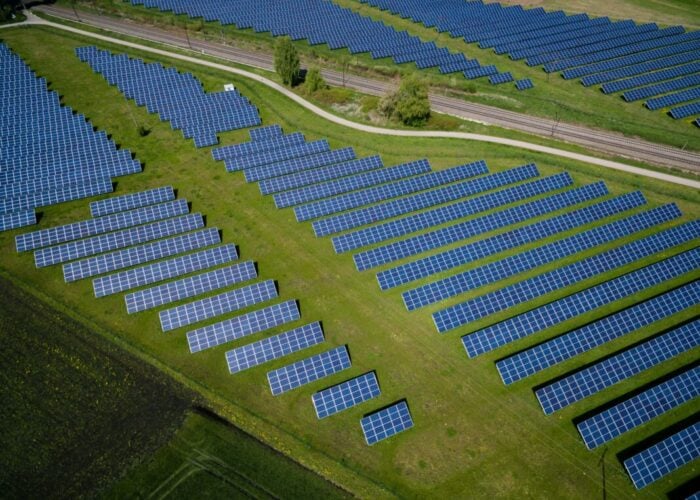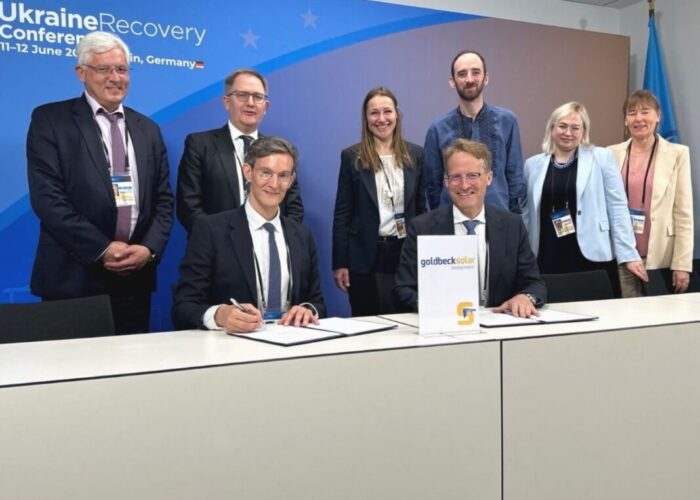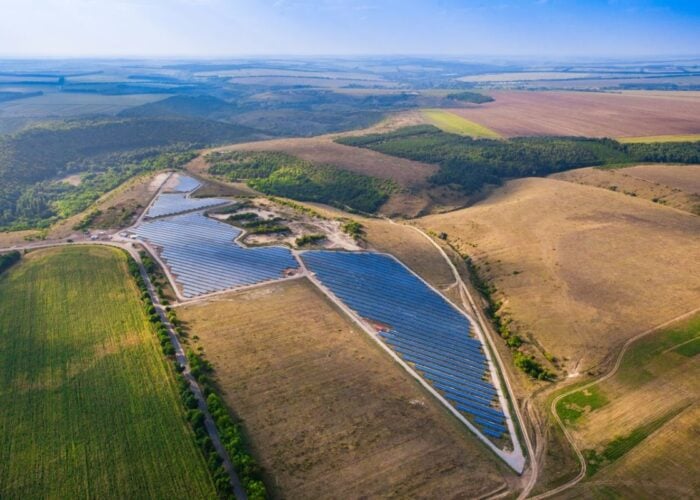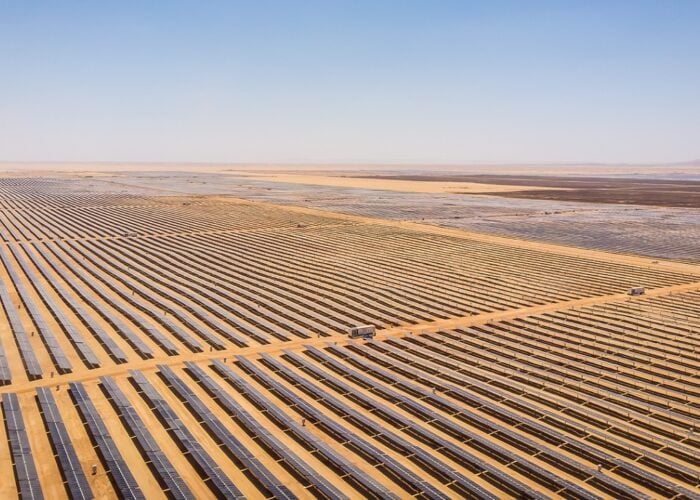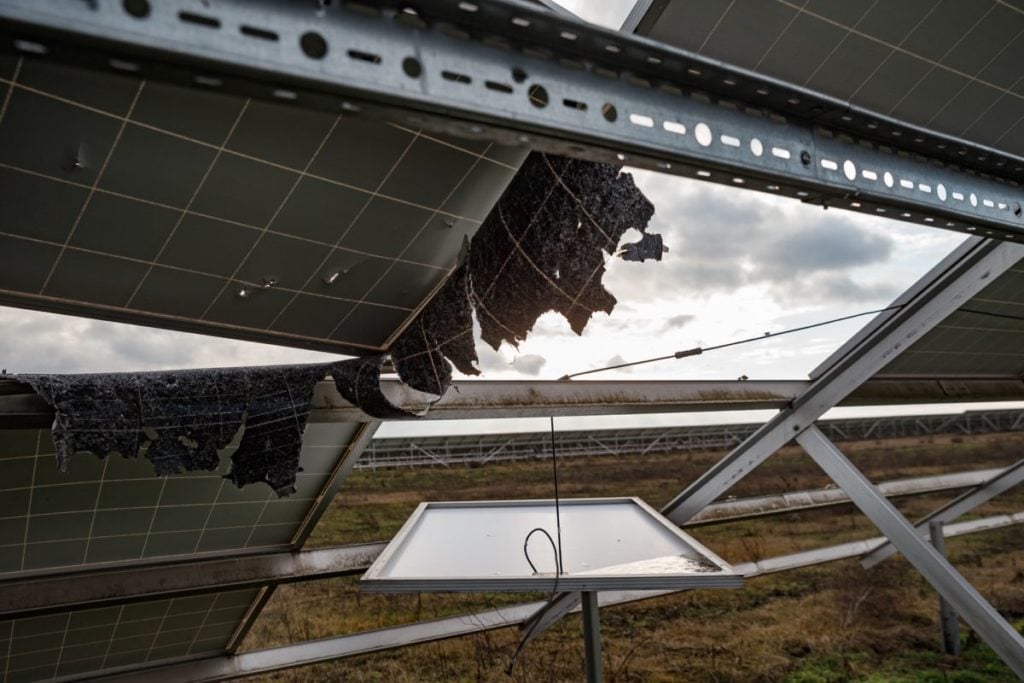
Energy infrastructure is often a primary target in a war, throwing people into darkness and limiting a vast number of services and technologies. This has increasingly led companies and countries to look to technologies like solar, which can bring light to countries gripped by war.
As a technology, it is cheap, fast to deploy and once running doesn’t rely on regular fuel input, as well as being capable of being rolled out in a vast number of sizes and locations.
Unlock unlimited access for 12 whole months of distinctive global analysis
Photovoltaics International is now included.
- Regular insight and analysis of the industry’s biggest developments
- In-depth interviews with the industry’s leading figures
- Unlimited digital access to the PV Tech Power journal catalogue
- Unlimited digital access to the Photovoltaics International journal catalogue
- Access to more than 1,000 technical papers
- Discounts on Solar Media’s portfolio of events, in-person and virtual
“Solar systems can provide a reliable energy source during emergencies such as power outages caused by natural disasters or conflicts. But more importantly, they can be used for a long-term energy supply,” says Bartosz Majewski, CEO at PV distributor Menlo Electric.
“The essential advantage of solar systems during the targeted attacks on energy infrastructure in a centralised energy system is their decentralised nature. Solar systems, especially hybrid or off-grid ones, provide a stable energy supply that can operate independently of the primary grid and are more resilient against missile attacks. The most telling example for me was how household solar stations saved the lives of residents of surrounded Mariupol, allowing them to cook food. I wish it would not be an exception, and more people could survive because they had access to electricity.”
Already we’ve seen solar’s use in areas including Syria, Yemen and – over the past year – Ukraine, as nations work to provide energy security in incredibly challenging conditions.
Solar in war zones around the world
The potential of solar to provide power to areas gripped by war is fairly well established. For example, amid the continued fighting in Yemen, a number of charities and companies have rolled out solar to support people as the crisis in the country enters its ninth year.
In March 2015, Yemen’s largest power plant in Marib, which was responsible for powering most of the country, went offline. The high power prices of private generators and frequent fuel shortages meant this closure threw the majority of the country into darkness, according to the World Bank.
But following on from this, there has been a significant growth in the number of firms importing and selling cheap solar systems, with many small electronics retailers offering them.
For those who still found the cost prohibitive, projects such as the World Bank’s Yemen Emergency Electricity Access Project have helped fill the void. Between 2018 and 2022, it installed solar systems at 91,715 households in rural and peri-urban areas, and installed a total of 6.45MWp of solar across 517 critical facilities, along with wider work to bring solar power to women impacted by the war and develop the skills and supply chains needed to keep growing the sector.
Today more than half of all Yemenis use solar power as their main source of lighting, according to the World Bank.
Elsewhere, solar has been used during the war in Syria, where initiatives like the Union of Medical Care and Relief Organizations’ (UOSSM) ‘Syria Solar’ has been providing the technology to hospitals, to support their function even in challenging conditions.
Commenting back in 2019, Dr Anas Al Kassem, board member at UOSSM International and war surgeon, said: “In the past three months, 34 medical facilities have been bombed in north-western Syria. After eight years of conflict, the electrical grid in many parts of Syria has become dysfunctional leading many health facilities to depend on diesel generators for electricity. Frequent shortages of fuel and gouging fuel prices jeopardise patient lives.”
The group launched a second solar power system in north-western Syria on 22 July 2019. The 90kWp solar PV system was made up of 300 panels, 12 inverters, 216 batteries and an advanced data control system.
Not only do these systems support the continued operation of crucial infrastructure, but they also save approximately 60,000 litres of diesel fuel per year. This represents 40-45% of the annual energy cost for the hospital, allowing that money to be redirected to providing medical care.
Rebuilding solar in liberated areas of Ukraine
When war broke out in Ukraine following the Russian invasion on 24 February 2022, energy infrastructure quickly became a key concern, both in the country and beyond. Artillery and rocket strikes have targeted generators, the grid network and the wider energy sector, with 30% of Ukraine’s power stations destroyed as of October 2022.
One glimmer of hope however was the Tryfonivska solar plant in the Kherson region, where activities resumed in November following liberation from Russian forces. The 10MW solar site’s owner and operator DTEK has since worked amid the challenges of war to energise the site, allowing it to once again contribute to the energy mix in the country.
The site holds a particular place of importance for the company, says DTEK Renewables CEO Oleksandr Selyshchev, meaning its liberating provided a particular morale boost to the company and the local region. “We construct much larger PV stations, but as our first child [Tryfonivska is] especially important for us, and we were very glad when we understood that the station was deoccupied in early October.”
In November, the company got permission to return to the site following assessments by the military confirming that it had been largely demined. There is a deficit of sappers and other demining specialists currently, delaying the return.
Once DTEK was back on site, it could begin to assess the damage. About 40% of panels and 30% of inverters were damaged, destroyed or stolen, says Selyshchev, but the biggest blow was that the local substation was destroyed completely.
“A key task for us now is to help our regional distribution company Khersonoblenergo to install new transformers. Unfortunately, some of Khersonoblenergo has suffered a lot. They have a lack of employees, a lack of liquidity. Actually, we use our labour force from our sister company, DTEK Grids [to help them]. They are helping them to restore wires, and now we are discussing several alternatives for how to renew usage of medium- or high-voltage grid, as soon as possible.”
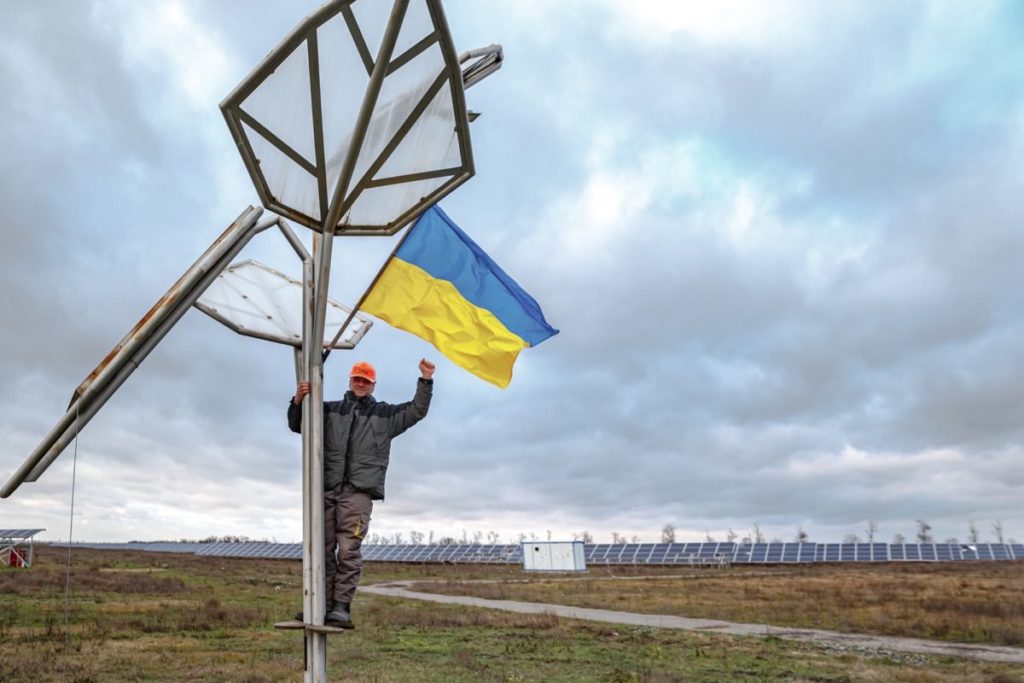
Having returned to the site, and constructed the workers’ village needed to allow additional staff, DTEK began rebuilding. This included assessing each panel and inverter, removing the broken ones and reconfiguring the site to run using the ones that remained.
While this is a somewhat unusual task for solar developers, according to Selyshchev this is one the team took in its stride, benefitting from a new mindset that is driving the Ukrainian people more broadly.
“It’s not like a typical life. The war changed the mindset. So we are struggling even more to achieve our goals,” he says.
As such, the operational team – which would usually be responsible for controlling electricity flows – took up a range of tasks, from reassembling inverters to cleaning out the administrative building after the Russians.
“I really think that our employees are heroes, the people who accept the risks, as the territory is still not completely demined – of course, we mark with special strings, mark safe roads and restrict dangerous areas. But all of us understand that, as I said, it’s not like a completely safe atmosphere, and they really are heroes,” says Selyshchev.
Whilst work is being undertaken to restore the substation, the Tryfonivska solar plant has been connected to a low-voltage line, allowing it to feed 2MW into the system.
“Of course, we understand it’s not huge, but it’s really important, at least for local villages, and small cities, because the original grid suffered a lot. And in any case, it’s really useful to support the grid system in the region with our even small capacity,” says Selyshchev.
When possible, DTEK plans to bring the site back up to its previous capacity, but will face challenges around sourcing panels and inverters similar enough to fit into the system.
Modular systems and rooftop aid
Along with the large-scale solar sites in Ukraine helping to provide vital clean energy, there are a number of smallerscale projects popping up to roll out generation at speed.
Lithuania-based solar module company SoliTek has been donating solar panels to Ukraine as part of humanitarian projects, which are being used to build mobile power generation stations. These are being used by Ukrainian soldiers to charge reconnaissance drones as well as by medics in mobile medical stations.
As well as being suited to modular solutions, solar has the additional benefits of being easy to transport, small and compact, as well as not emitting any noise and not requiring fuel as a consumable.
Similar solutions are being offered through other collaborative partnerships such as Computer Aid International, Community Organised Relief Effort, Simplyhealth and Geeks without Frontiers, for example, who are rolling out solutions like the portable connectivity container on the ground in Ukraine.
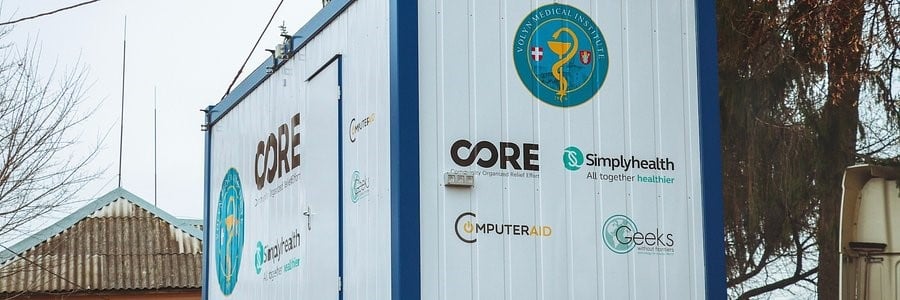
These are solar-powered converted shipping containers, the first of which was installed at the Volyn Medical Institute in Lutsk, Ukraine, in December, where it is helping to support training for medical students.
Elsewhere, companies are working to deploy fixed solar installations at pace as well. For example, Menlo Electric is working in cooperation with the Ukrainian foundation Energy Act For Ukraine (EA4U) to roll out ten installations with a total output of 300kW at schools and hospitals.
“The project aims to reduce the number of hours when the facilities are operating without electricity and enable schools and hospitals to use stored electricity during power outages, while reducing their dependence on the grid and the energy bills respectively,” says Yuliana Onishchuk, founder of the EA4U.
“Hospitals are experiencing serious problems with electricity supply, or worse, not having it at all. This makes it hard to provide medical assistance and, in some situations, impossible to save lives. The foundation’s goal is to equip 50 hospitals and 100 schools with solar stations within the next five years.”
EA4U then conducts a multi-stage selection process to choose the most appropriate sites for is 100RESforSchools and 50RESforHospitals programmes. One of the key considerations is proximity to the front line and Russian and Belarus borders, with sites having to sit beyond 60km from such.
The schools and hospitals need to be operational, with this including schools that are offline or using mixed forms of attendance meaning that they are equipped with an underground bomb shelter under Ukrainian legislation. Additionally, the roof cannot be made of slate, given how brittle it is, creating additional risk during the installation process.
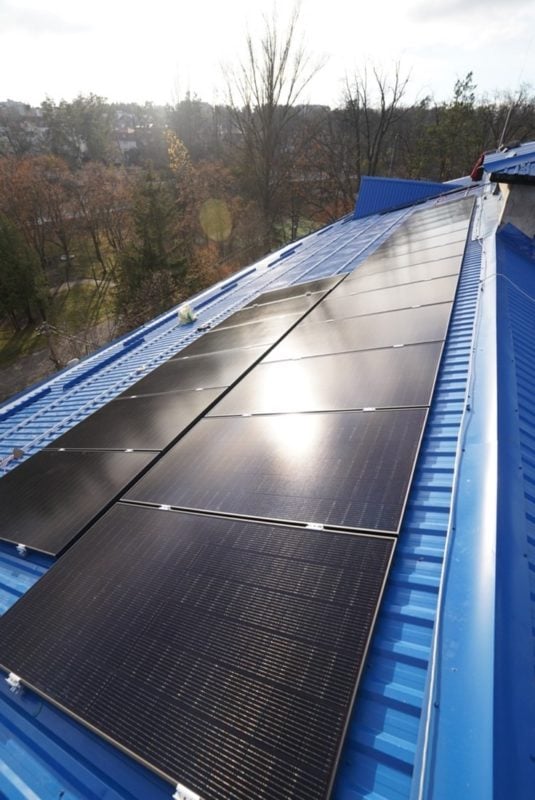
Hospitals have been chosen that have surgery rooms, intensive care units, and maternity wards, as these are medical departments that most critically require a stable electricity supply. This is also a driving factor in the inclusion of a battery energy storage asset alongside the solar at these sites.
“While choosing energy storage, its capacity plays an important role, especially for hospitals, where uninterrupted power supply is essential for critical equipment such as life support systems, ventilators and surgical instruments. The capacity of hospital storage batteries is usually at least twice that of a solar power plant to cover the energy demand of the required critical equipment at the surgery rooms/intensive care units/maternity wards for an extended period, usually several hours,” says Menlo Electric CEO Majewski.
“When deciding on the capacity of the solar system for a school, we take into account the consumption of the bomb shelter (wired by default to our solar system), several classes chosen by the school (usually IT classrooms that need electricity for computers) and street lighting (for ensuring the security of pupils going home after classes when there is no daylight).”
The typical configuration of projects is shown in the table below:
| School | Hospital | |
| Solar modules | 20-40kWdc | 30-50kWdc |
| Hybrid three-phase inverters | 10-30kW | 20-35kW |
| Battery storage | 20-50kWh | 60-96kWh |
Installing solar during wartime brings numerous additional challenges, alongside the clear benefits it offers.
“The security-related risks of constructing a rooftop solar power plant in Ukraine have never been higher than after 24.02.2022, and so is the need for decentralised energy sources. The latter is why we proceeded doing our projects, a decentralised renewable generation and energy storage facilities can secure essential critical and social infrastructure operations during the war. So, lives continue to be saved and kids keep studying no matter what,” says Yuliana Onishchuk, founder of the EA4U.
“The lack of skilled workers may become more pressing from the middle to long-term perspective. Before the full-scale invasion, the Ukrainian energy sector employed significantly more men, especially in STEM jobs. Currently, many men are conscripted into the Armed Forces of Ukraine, and as long as the war continues, many more may be called to fight. It potentially can increase the deficit of skilled engineers, mounting specialists and electricians who work with renewables.”
However, the biggest challenge is securing a sufficient and constant flow of donations, according to Onishchuk. The EA4U is targeting installations in 100 and 50 schools and hospitals, respectively, by 2028.
Reducing overreliance on fossil fuels in the long term
It is clear that solar can provide a vital source of power to those impacted by war, helping to keep day-to-day life running and supporting vital infrastructure. Additionally, as a fundamentally independent generation source, it provides greater security for countries moving forward, ensuring they are less reliant on large petro-states such as Russia.
Interest in solar since the Russian invasion of Ukraine has surged not just in Ukraine but across Europe, as nations look to develop additional resiliency.
“With renewables demonstrably cheaper, safer and more resilient than overreliance on imported fossil fuels, the clear lesson is that energy security and net zero can, and must, go together,” said Bernice Lee of thinktank Chatham House on the anniversary of the invasion.
“The response to the conflict has also demonstrated that where there is a will, there are many ways to cleaner futures, as seen by the rallying of the Europeans around efficiency. A year on from the invasion, the shift towards cleaner technologies is only accelerating, with the landmark US Inflation Reduction Act spurring the EU to enter into a race to develop the clean technologies of the future.”
This article originally appeared in PV Tech’s quarterly publication, PV Tech Power. You can read the latest issue, PV Tech Power 34 here.


